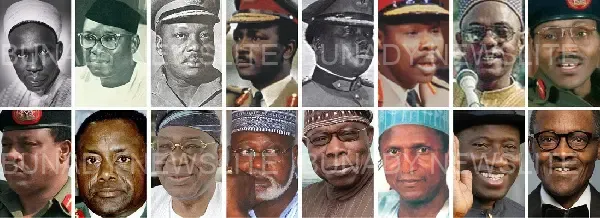June 12: Full List of Heads of State and Presidents Since
June 12 holds a deep meaning in Nigeria’s history. It commemorates the landmark 1993 presidential election widely regarded as the freest and fairest in the nation’s past, only to be annulled days later....READ ORIGINAL & FULL CONTENT FROM SOURCE |
In 2018, the federal government officially moved “Democracy Day” from May 29 to June 12, honouring the courage of Nigerians who demanded genuine democratic rule.
WONDER SHALL NEVER END: Watch Video Now| Mother Get Jealous, Poisoned Her Only Son Girlfriend, Says She’s Taken Away His Attention From Her. Watch The Full Video Clip Before It’s Deleted On Social Media.
As we mark June 12, it’s fitting to reflect on the list of Presidents and Heads of State that Nigeria has had since independence, tracing the journey from ceremonial leadership to modern civilian governance.
From Ceremonial President to Military Rule (1963–1979)
Dr. Nnamdi Azikiwe (1963–1966) – Ceremonial President
When Nigeria became a republic on October 1, 1963, Nnamdi Azikiwe transitioned from Governor-General to the country’s first President. Serving in a largely symbolic capacity, he represented national unity as the young country navigated regional tensions.
Major General Johnson Aguiyi-Ironsi (1966) – Military Head of State
In January 1966, a coup led by young military officers brought Major General Aguiyi-Ironsi to power. His six-month rule sought to centralise authority, but rising ethnic distrust led to his overthrow and assassination in July 1966.
General Yakubu Gowon (1966–1975) – Military Head of State
After Ironsi’s fall, Lieutenant Colonel Yakubu Gowon emerged as Head of State. He steered Nigeria through the civil war (1967–1970), secured national reunification, and launched the “Operation Feed the Nation” agricultural program.
General Murtala Mohammed (1975–1976) – Military Head of State
Known for his bold reforms and anti-corruption drive, General Mohammed modernised the bureaucracy and initiated the move of the federal capital from Lagos to Abuja. His assassination in February 1976 cut his popular tenure short.
General Olusegun Obasanjo (1976–1979) – Military Head of State
Handpicked by his predecessor, General Obasanjo completed the transition plan to civilian rule. He organised the 1979 elections, handed over power peacefully, and set a precedent for future transfers of authority.
Nigeria’s Second Republic and Return to Military Rule (1979–1999)
Alhaji Shehu Shagari (1979–1983) – Civilian President
Elected under the platform of the National Party of Nigeria, President Shagari championed agricultural expansion and infrastructure projects. Economic downturns and corruption allegations, however, undermined his administration, paving the way for a coup in December 1983.
Major General Muhammadu Buhari (1983–1985) – Military Head of State
Buhari’s regime focused on discipline and “War Against Indiscipline” campaigns. His strict measures reduced crime but alienated many. He was deposed in August 1985.
General Ibrahim Babangida (1985–1993) – Military Head of State
Babangida’s tenure was marked by economic restructuring through the Structural Adjustment Program. He also established the National Electoral Commission and organised elections, but controversially annulled the June 12, 1993, presidential results.
Chief Ernest Shonekan (August–November 1993) – Interim Head of State
Following Babangida’s resignation, Ernest Shonekan led an interim civilian government. His six-week administration struggled with legitimacy and was ended by a coup later in 1993.
General Sani Abacha (1993–1998) – Military Head of State
Often cited as one of Nigeria’s most repressive rulers, Abacha’s regime curtailed political freedoms even as he maintained high oil revenues. He died suddenly in office in June 1998.
General Abdulsalami Abubakar (1998–1999) – Military Head of State
Abubakar quickly organised new elections, lifted many political restrictions, and handed over power to an elected civilian president in May 1999, inaugurating the Fourth Republic.
The Fourth Republic: Sustained Civilian Governance (1999–Present)
Chief Olusegun Obasanjo (1999–2007) – Civilian President
Returning to power as a democratically elected president, Obasanjo focused on debt relief, economic reforms, and regional peacekeeping. His two terms brought Nigeria back onto the global stage.
Umaru Musa Yar’Adua (2007–2010) – Civilian President
Yar’Adua prioritised the rule of law and the Niger Delta amnesty program. His sudden health challenges led to a constitutional first when power was temporarily transferred to his vice president.
Dr. Goodluck Jonathan (2010–2015) – Civilian President
Jonathan oversaw GDP growth that briefly placed Nigeria among the world’s top 20 economies. He also navigated the rise of Boko Haram insurgency and conducted a peaceful transfer of power after losing the 2015 election.
President Muhammadu Buhari (2015–2023) – Civilian President
In his democratic tenure, Buhari launched anti-corruption efforts, stabilised the currency, and strengthened security in the northeast. Though challenged by economic headwinds, he maintained Nigeria’s strategic role in West Africa.
President Bola Ahmed Tinubu (2023–Present) – Civilian President
Sworn in on May 29, 2023, President Tinubu has embarked on economic reforms, including tax overhauls and fuel subsidy removal. His administration continues to face the twin tasks of reviving growth and addressing security concerns.
WONDER SHALL NEVER END: Watch Video Now| Mother Get Jealous, Poisoned Her Only Son Girlfriend, Says She’s Taken Away His Attention From Her. Watch The Full Video Clip Before It’s Deleted On Social Media.

